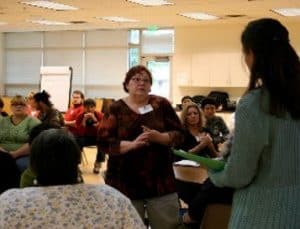What I learned about pandemic preparedness in Seattle
20 March 2020Believe it or not, I have been through a pandemic with Seattle before—and long before anyone had heard of COVID-19.
I know, no way.
Most of us have never seen anything like this before. Some of our elders have distant memories of rations during WWII, but many people are experiencing a world of restrictions and controls beyond anything we have ever imagined. But about 10 years ago, a group of people in Seattle—myself included—did imagine this, asking: What would it be like in Seattle during a pandemic if the medical system were overloaded and there were insufficient life-saving resources to go around?
Anticipating the worst-case scenario
I’ve worked on a lot of projects in my 20 years with Meridian, but this one stands out more than any other. In 2009, I worked with Seattle & King County Public Health on pandemic planning, one in a series of pandemic planning projects Meridian conducted with the Centers for Disease Control (CDC). Our mission was to inform policies for the County health care system in public health emergencies—providing guidance on making fair, equitable, sometimes life-or-death decisions.

In Seattle, the scenario we posed was a severe, large-scale flu pandemic, during which medical services and supplies would be in short supply. Sound familiar? It’s a scenario that has tragically become all too real in the greater Seattle region, a hotspot of the COVID-19 outbreak.
Making life-or-death decisions, from the ground up
Meridian worked with the County to conduct focus groups and listening sessions with over 150 participants from all walks of life in Seattle, including sessions for Spanish-speaking populations, homeless communities, and individuals with special needs. From the conference rooms of City Hall to community centers around the region, I heard profound messages:
- Even if it means compromising care, the primary goal should be benefiting the greatest number of people.
- Medical decisions should be different during a pandemic, but those decisions should be consistent, clearly communicated and understood, and equitable.
- When excruciating ethical decisions must be made about who gets access to life-saving resources like respirators, we should take into account the number of years a person would live and the quality of their life if they survive.
- Maintaining emergency and essential services must be a priority: not just healthcare workers and first responders, but also others such as utility personnel who keep the power on and maintain drinking water, grocery store employees, and waste collectors.

Even in hypothetical scenarios, these community conversations were hard. My goal was to build a sense of unity and respect—even as disagreements surfaced. We dove into controversial questions in small groups, so participants could voice their concerns and hear each other. We framed choices in a way that focused on underlying values. We grappled with the deeply personal ethics of prioritizing one life over another. We found solutions amidst overwhelming challenges.
Times of crisis can sow division, but Seattle taught me that crisis can also bring people together as a community to make decisions that transcend individual interests.
As a trusted third-party, Meridian was able to shepherd each conversation—and observed a transformative experience. Community members made their values understood. And as we understood each other, the tough choices made sense. People don’t always like an outcome but when we understand it, we are more likely to abide by the decision and, better yet, work together to implement it. Through this process, these communities were left better prepared to make difficult decisions, and the results informed county and hospital policies for allocating scarce resources in the event of a pandemic.
From pandemic planning to pandemic response
Unfortunately, our scenario is no longer a hypothetical: the coronavirus pandemic is happening right now. It is chilling to read news of how these very same decisions—about managing limited resources, about evaluating one life over another—are playing out in hospitals in Seattle and around the world.
Times of crisis can sow division, but Seattle taught me that crisis can also bring people together as a community to make decisions that transcend individual interests. Collaborative pandemic planning allows communities to proactively think through how to assure the greatest good—for our neighbors and friends, grandparents and colleagues, service providers and children.
“Our best strategies depend on millions of residents actively following established disease prevention guidelines,” King County Executive Dow Constantine cautioned earlier this month. I’m proud of the work we did with the team at Seattle & King County to foster that collective commitment to public health through community-based pandemic planning. I hope that spirit carries through into pandemic response. We may be physically separated from each other right now—but our response to stem this crisis inherently depends upon our ability to unite.

Learn more
Find out more about the pandemic planning process Meridian facilitated in King County.